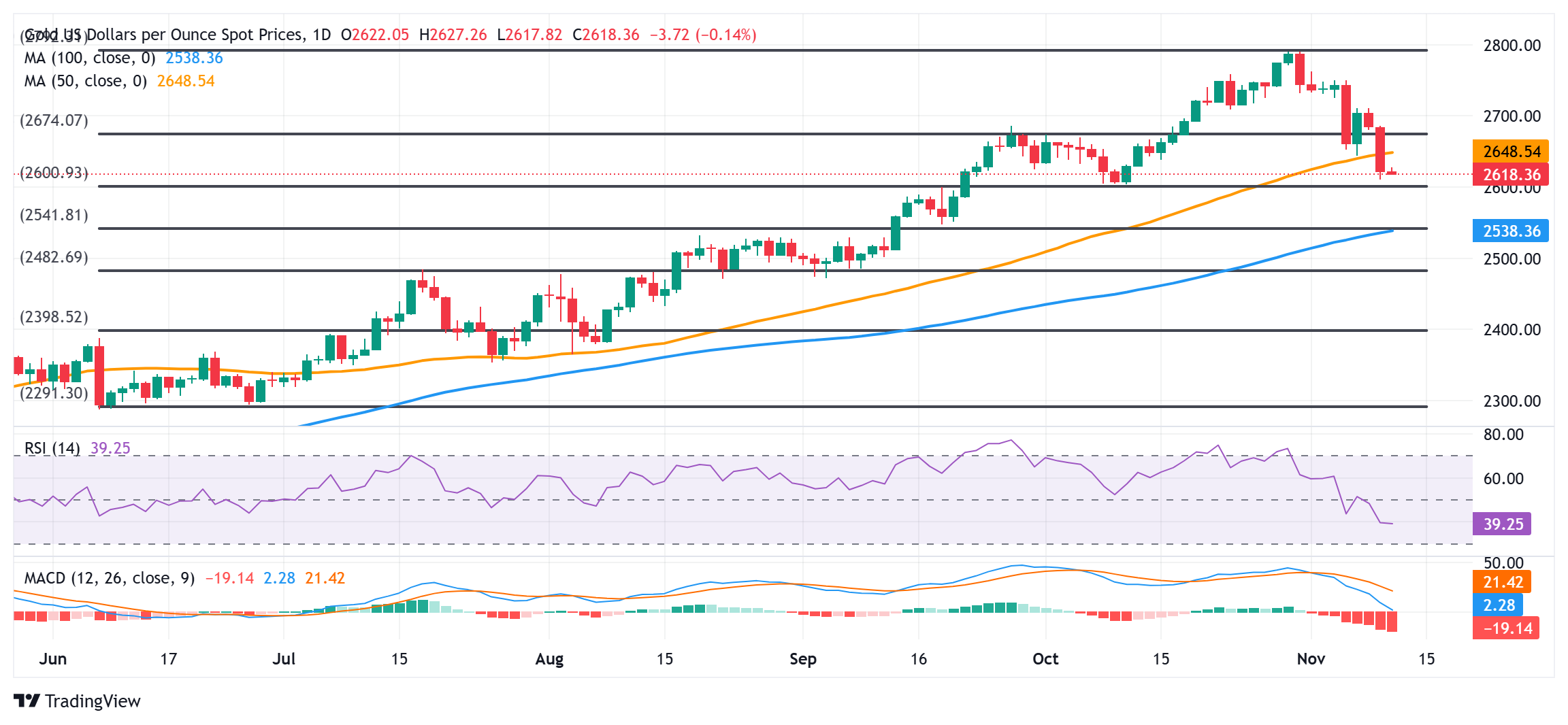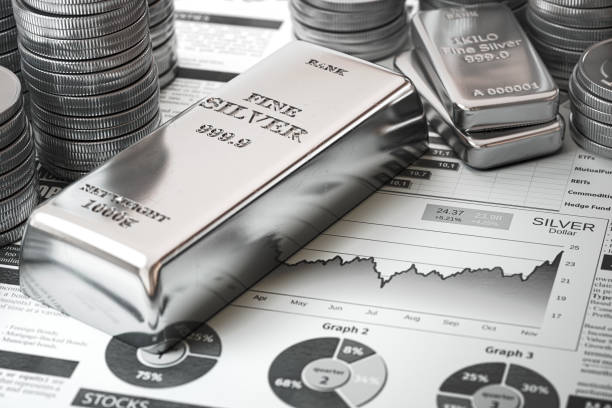Gold price consolidates above one-month low, not out of the woods yet


- Gold price ticks higher, though it remains close to a one-month low touched on Monday.
- The Trump-related trades keep the USD near a multi-month peak and cap the precious metal.
- Elevated US bond yields support prospects for XAU/USD to experience further downside.
Gold price (XAU/USD), after recording its steepest weekly decline in over five months, fell over 2% on Monday and dived to its lowest level since October 10 amid strong follow-through US Dollar (USD) buying. Traders anticipate a cautious approach from the Federal Reserve (Fed) moving forward amid hopes that US President-elect Donald Trump's politics will boost economic growth and inflation. This, in turn, remains supportive of elevated US Treasury bond yields, which pushed the USD to over a four-month top and weighed heavily on the non-yielding yellow metal.
The downward trajectory, however, stalled ahead of the $2,600 mark, amid fears that Trump’s protectionist policies will impact the global economy. This, in turn, drives some haven flows and assists the Gold price in holding steady during the Asian session on Tuesday. Any meaningful recovery, however, seems elusive in the wake of the underlying strong bullish sentiment surrounding the USD. Traders might also opt to wait on the sidelines ahead of this week's release of the US consumer inflation figures and speeches by influential FOMC members, including Fed Chair Jerome Powell.
Gold price draws some support from concerns about Trump’s protectionist policies
- The US Dollar prolonged its positive trend that followed Donald Trump's victory in the US presidential election and shot to its highest level since early July, which prompted heavy selling around the Gold price on Monday.
- Trump's expansionary policies and corporate tax cuts could put upward pressure on inflation, and limit the Federal Reserve's scope to ease its monetary policy more aggressively. This continues to underpin the Greenback.
- Minneapolis Fed President Neel Kashkari said on Sunday that the central bank wants to have confidence and needs to see more evidence that inflation will go back to the 2% target before deciding on further interest rate cuts.
- The US Treasury bond yields hold steady below the post-US election swing high as investors assess broader implications of Trump's victory in the US presidential election on fiscal policy and interest rate cut expectations.
- Before the election, Trump had pledged to impose a universal 10% tariff on imports from all countries. This fuels concerns about an escalation of the global trade war and offers some support to the safe-haven XAU/USD.
- Traders now await speeches from influential FOMC members, including Fed Chair Jerome Powell, for cues about the future of interest rates in the US amid speculations that the US central bank might delay its easing cycle.
- According to the CME Group's Fedwatch tool, traders are now pricing in a 65% chance of another 25-basis-point rate cut by the Fed and a 35% probability of a ‘no change’ at the next FOMC monetary policy meeting in December.
- Investors this week will also confront the release of the US consumer inflation figures and the US Producer Price Index (PPI), which might contribute to determining the next leg of a directional move for the commodity.
Gold price could accelerate the fall once the $2,600 mark is broken

From a technical perspective, the overnight breakdown below the 50-day Simple Moving Average (SMA) was seen as a fresh trigger for bearish traders. Moreover, oscillators on the daily chart have been gaining negative traction and are still away from being in the oversold zone, suggesting that the path of least resistance for the Gold price is to the downside.
That said, the overnight slump stalled ahead of the $2,600 mark, which represents the 38.2% Fibonacci retracement level of the June-October rally and should act as a key pivotal point. A convincing break below the said handle should pave the way for an extension of the recent pullback from the all-time peak and drag the Gold price to the $2,540-2,539 confluence. This comprises 50% Fibo. level and the 100-day SMA, which if broken decisively will reaffirm that the XAU/USD has topped out in the near term.
On the flip side, the $2,632-2,635 area now seems to act as an immediate hurdle, above which a bout of a short-covering move could lift the Gold price to the $2,659-2.660 static resistance. A sustained strength beyond the latter should pave the way for a move towards the $2,684-2,685 region en route to the $2,700 mark and the $2,710 supply zone. Some follow-through buying will suggest that the recent corrective decline has run its course and shift the bias back in favor of bullish traders.
Gold FAQs
Why do people invest in Gold?
Gold has played a key role in human’s history as it has been widely used as a store of value and medium of exchange. Currently, apart from its shine and usage for jewelry, the precious metal is widely seen as a safe-haven asset, meaning that it is considered a good investment during turbulent times. Gold is also widely seen as a hedge against inflation and against depreciating currencies as it doesn’t rely on any specific issuer or government.
Who buys the most Gold?
Central banks are the biggest Gold holders. In their aim to support their currencies in turbulent times, central banks tend to diversify their reserves and buy Gold to improve the perceived strength of the economy and the currency. High Gold reserves can be a source of trust for a country’s solvency. Central banks added 1,136 tonnes of Gold worth around $70 billion to their reserves in 2022, according to data from the World Gold Council. This is the highest yearly purchase since records began. Central banks from emerging economies such as China, India and Turkey are quickly increasing their Gold reserves.
How is Gold correlated with other assets?
Gold has an inverse correlation with the US Dollar and US Treasuries, which are both major reserve and safe-haven assets. When the Dollar depreciates, Gold tends to rise, enabling investors and central banks to diversify their assets in turbulent times. Gold is also inversely correlated with risk assets. A rally in the stock market tends to weaken Gold price, while sell-offs in riskier markets tend to favor the precious metal.
What does the price of Gold depend on?
The price can move due to a wide range of factors. Geopolitical instability or fears of a deep recession can quickly make Gold price escalate due to its safe-haven status. As a yield-less asset, Gold tends to rise with lower interest rates, while higher cost of money usually weighs down on the yellow metal. Still, most moves depend on how the US Dollar (USD) behaves as the asset is priced in dollars (XAU/USD). A strong Dollar tends to keep the price of Gold controlled, whereas a weaker Dollar is likely to push Gold prices up.





